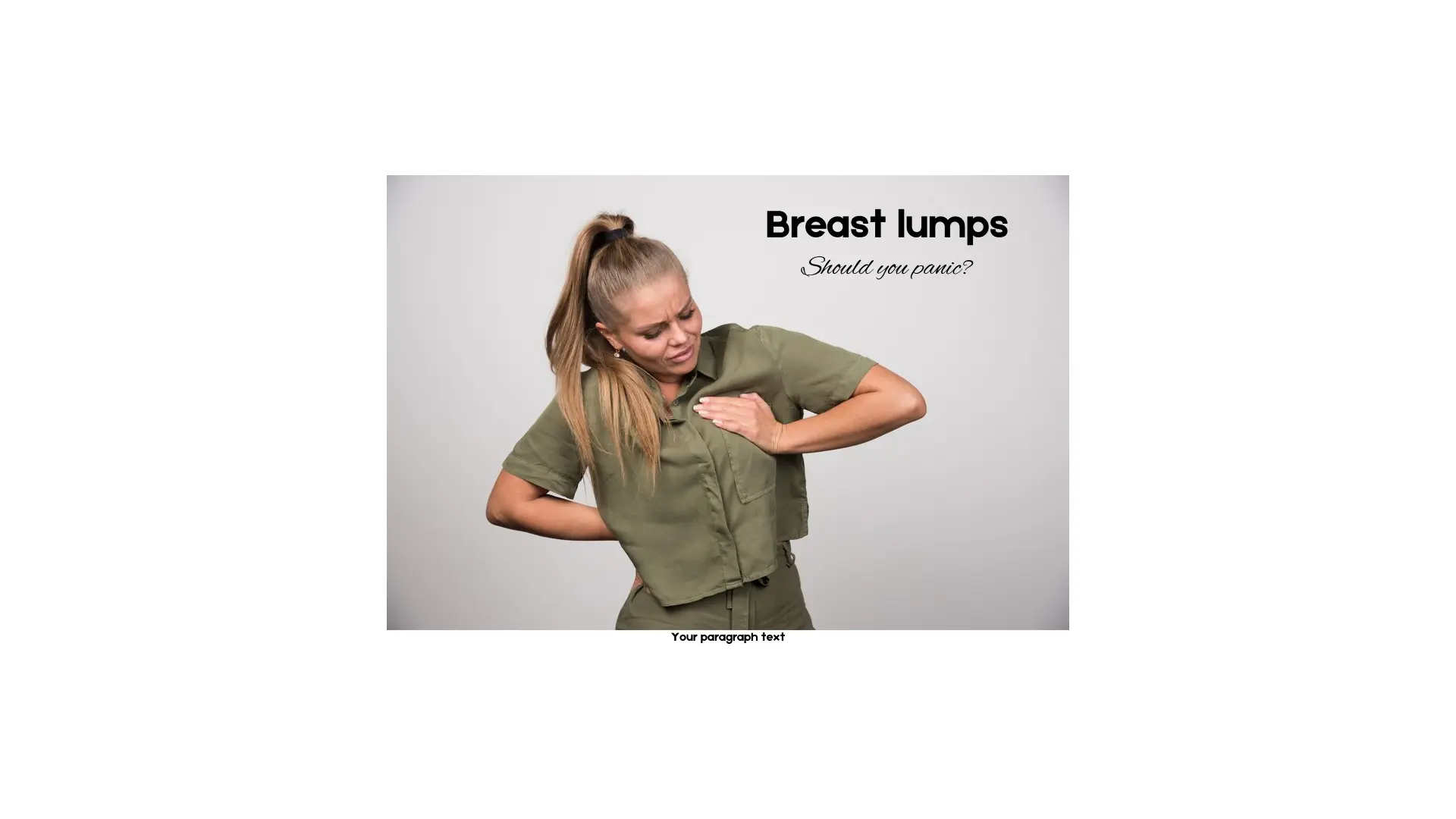
Breast Lumps: Should You Panic? Let’s Break It Down
Finding a lump in your breast can be a scary experience—but before you panic, take a deep breath. Most breast lumps aren’t cancerous, but it’s important to understand what they are, when you should be concerned, and when you can relax. This post will guide you through the different types of breast lumps, help you understand when it’s time to see a doctor, and offer comfort if you find yourself feeling anxious.
What Are Breast Lumps?
A breast lump is simply an abnormal growth of tissue in the breast. It can feel like a hard or soft bump that you can feel under the skin. Lumps can be located in one or both breasts and might vary in size, shape, and consistency.
It’s normal for women’s breasts to change throughout their lives due to hormones, age, or menstrual cycles. However, a lump can sometimes be a sign of something more serious. Understanding the types of lumps and how they feel can help you make better decisions about when to see a healthcare provider.
Different Types of Breast Lumps: What Do They Mean?
1.Fibrocystic Breast Lumps (Non-Cancerous)
Fibrocystic changes in the breast are incredibly common, especially among women in their 30s and 40s. These lumps often feel firm or rubbery and may fluctuate in size or tenderness depending on where you are in your menstrual cycle. Fibrocystic lumps are typically benign and don’t require treatment unless they cause significant pain.
When to relax: If the lump feels movable, soft, and painful at certain times of the month, it’s likely fibrocystic tissue, which is not cancerous.
2. Cysts (Non-Cancerous Fluid-Filled Lumps)
A cyst is a fluid-filled sac that can develop in the breast. They are common and can feel round, smooth, and sometimes tender to the touch. Hormonal fluctuations can cause cysts to form, often making them appear during certain times of the menstrual cycle.
When to relax: Cysts are typically benign and can be drained by a doctor if they cause discomfort, but they generally don’t require further action.
3. Fibroadenomas (Benign Tumors)
Fibroadenomas are solid lumps that are usually round and feel firm or rubbery. These non-cancerous tumors are common in young women, especially in their 20s and 30s, and can vary in size. They are typically painless, movable, and slow-growing.
When to relax: Fibroadenomas are usually benign and require no treatment unless they grow larger or cause discomfort.
4. Infections (Abscesses)
A breast abscess is a localized collection of pus caused by infection. This type of lump is often painful, red, swollen, and might be accompanied by fever. These infections can occur after breastfeeding, when milk ducts become blocked, but they can also occur in women who are not breastfeeding.
When to visit a doctor: If the lump is painful, swollen, or red, and you have a fever, it’s important to see a doctor for antibiotics or drainage. Early treatment can help prevent complications.
5. Cancerous Breast Lumps (Malignant)
While most breast lumps are benign, it’s important to consider the possibility of breast cancer. Cancerous lumps are usually hard, painless, and immovable, although not all lumps fit this description. Early detection is crucial for effective treatment, so it’s important to visit your doctor if you notice any changes in your breast tissue, even if you’re not sure what the lump is.
When to be concerned: If you notice a hard, immovable lump, a change in the size or shape of your breast, skin dimpling, or nipple discharge, do not wait—see your doctor as soon as possible.
When Should You Panic?
The key to managing breast lumps is to stay calm and evaluate the situation. Remember, most breast lumps are not cancerous. However, there are some red flags that you should pay attention to:
- A lump that feels hard, fixed, or immovable
- A lump that changes size, shape, or consistency over time
- Pain or tenderness that doesn’t go away
- Skin dimpling, redness, or irritation around the lump
- Nipple discharge that’s bloody or clear, especially if it occurs without squeezing the nipple
If you notice any of these changes, it’s important to schedule an appointment with your healthcare provider as soon as possible. Early detection and quick action can be crucial for addressing potential health concerns.
When Should You Not Worry?
There are plenty of instances where a lump doesn’t mean anything serious. Here’s when you can relax:
- If the lump is soft, movable, and changes with your menstrual cycle.
- If the lump has been there for a while and hasn’t changed in size or shape.
- If you’ve had a mammogram or ultrasound before and the lump was found to be benign.
Even though these lumps are often harmless, it’s still important to monitor them and see a doctor if you notice any changes.
What to Do if You Find Breast Lumps?
1.Don’t Panic!
The first thing to do if you find breast lumps is stay calm. Most lumps are not cancerous. Take note of the lump’s size, texture, and any pain you might feel. It’s helpful to track if the lump changes over time.
2. Schedule a Check-Up
Make an appointment with your doctor for a clinical breast exam. Your doctor will ask about the lump’s characteristics and may recommend imaging tests, such as an ultrasound or mammogram, to get a better look at the lump.
3. Follow-Up
If your doctor suggests a follow-up, be sure to keep the appointment. Regular monitoring can help identify any changes early. If further testing or a biopsy is needed, it’s best to address it quickly, even if you’re told the lump is benign.
4. Check Regularly
Get into the habit of doing monthly self-breast exams. Understanding what your breasts look and feel like is the best way to catch any changes early. If anything feels different, don’t hesitate to reach out to your healthcare provider.
Conclusion
Your Health is in Your Hands: It’s important to remember that finding a lump doesn’t necessarily mean cancer. In fact, most lumps are benign and can be managed with little or no treatment. The most important thing is to stay proactive about your breast health, get to know your body, and seek guidance from a healthcare provider when needed. Trust yourself and your instincts—if something doesn’t feel right, getting a professional opinion is always the best choice.
No matter what, you’re not alone in this. Many women have faced the same fears, only to find out that the lump was completely harmless. Keep calm, stay informed, and know that taking control of your health is empowering. For more information, locate our Blog Section.
All Categories
Recent Posts
Before it’s Too Late: 5 Essential Things Women Need to Know about Breast Cancer
Dr. Joan Faluyi Receives Honorary Doctorate for Global Impact in Women’s Empowerment
October Awareness: Blossomflow’s Call to Women Everywhere
Tags
Give them a helping hand
Every donation fuels our mission to combat period poverty. Your generosity brings us closer to menstrual equity.
+234-909-482-1642
inquiries@blossomflow.org




